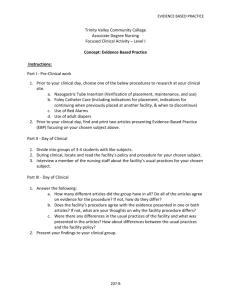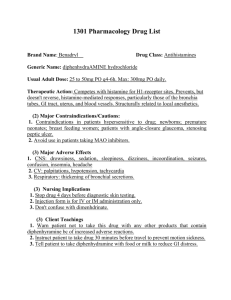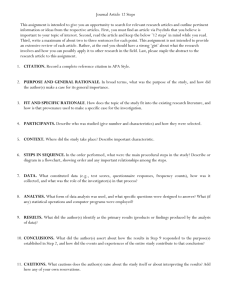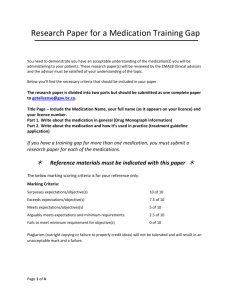Online Common Syllabus - OSU Institute of Technology
advertisement
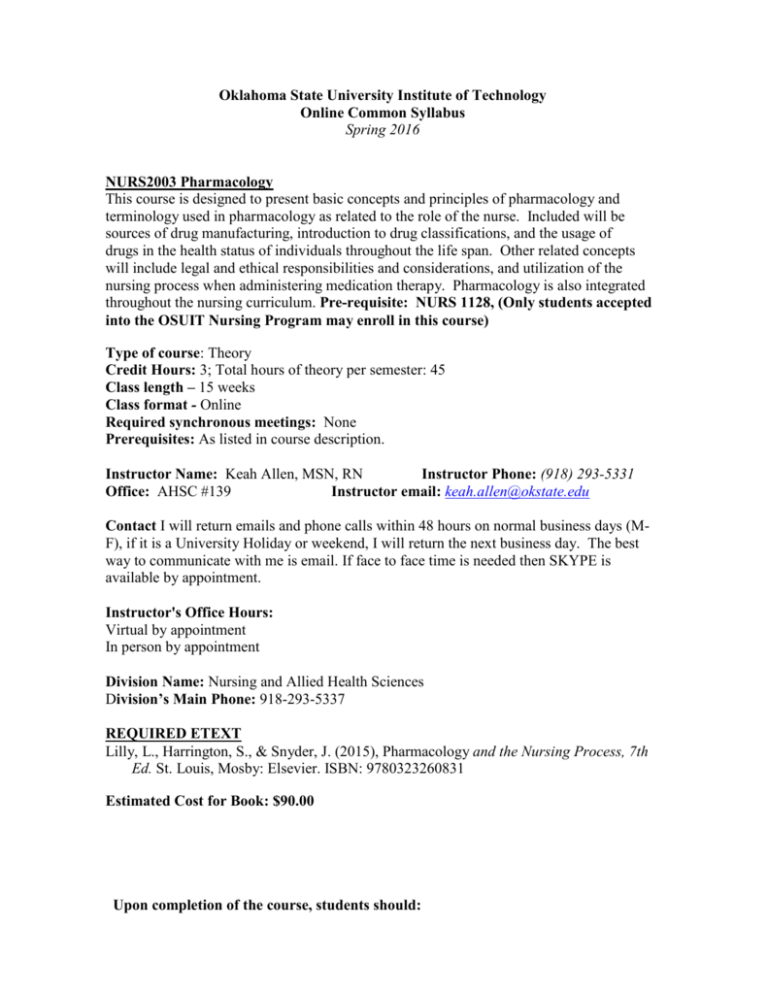
Oklahoma State University Institute of Technology Online Common Syllabus Spring 2016 NURS2003 Pharmacology This course is designed to present basic concepts and principles of pharmacology and terminology used in pharmacology as related to the role of the nurse. Included will be sources of drug manufacturing, introduction to drug classifications, and the usage of drugs in the health status of individuals throughout the life span. Other related concepts will include legal and ethical responsibilities and considerations, and utilization of the nursing process when administering medication therapy. Pharmacology is also integrated throughout the nursing curriculum. Pre-requisite: NURS 1128, (Only students accepted into the OSUIT Nursing Program may enroll in this course) Type of course: Theory Credit Hours: 3; Total hours of theory per semester: 45 Class length – 15 weeks Class format - Online Required synchronous meetings: None Prerequisites: As listed in course description. Instructor Name: Keah Allen, MSN, RN Instructor Phone: (918) 293-5331 Office: AHSC #139 Instructor email: keah.allen@okstate.edu Contact I will return emails and phone calls within 48 hours on normal business days (MF), if it is a University Holiday or weekend, I will return the next business day. The best way to communicate with me is email. If face to face time is needed then SKYPE is available by appointment. Instructor's Office Hours: Virtual by appointment In person by appointment Division Name: Nursing and Allied Health Sciences Division’s Main Phone: 918-293-5337 REQUIRED ETEXT Lilly, L., Harrington, S., & Snyder, J. (2015), Pharmacology and the Nursing Process, 7th Ed. St. Louis, Mosby: Elsevier. ISBN: 9780323260831 Estimated Cost for Book: $90.00 Upon completion of the course, students should: Course Objectives Identify basic principles and concepts related to drug therapy Assessment of Objectives Weekly discussions Weekly quizzes Analyze nursing implications associated with pharmacological agents to promote an optimal level of wellness. Weekly discussions Weekly quizzes Group Project Utilize the nursing process to meet individual’s drug therapy needs. Weekly discussions Weekly quizzes Correlates pharmacology research to nursing care Weekly discussions COURSE ACTIVITIES In this course students will: -Weekly reading assignments -Review PowerPoint presentation -Participation in online class activities, such as online group discussions and a group project -Complete quizzes GRADES WILL BE CALCULATED ON A WEIGHTED AVERAGE OF COMPLETION BASED ON THE QUALITY AND COMPLETION OF THESE TASKS: Grades for discussion and quizzes will be posted by Tuesday of the following week they are due. Project grades will be posted 1 week after their due date. Quizzes (13)……….…............50% Group Project (1)………………20% Discussion (14)……….…..….…30% OSUIT Nursing Grading Scale A = 92 – 100% B = 84-91% C = 75-83% D =74-66% F = 65% and below *The student’s grade for this assignment will be used in the university’s assessment of student learning. A 70% competency or higher receives a Pass rating. This Pass/Fail rating is independent of the student’s course grade. Grades for chapter quizzes are given immediately upon completion of the quiz. Quiz grades are subject to change if an error has occurred or if hand grading is required. Feedback on assignments will be provided within 1 week of submission. AUTHORIZED TOOLS Students may use any/all course materials, including books and notes, while participating in classroom activities. All quizzes and written assignments are to be completed independently; no collaboration with classmates is permitted and any instance of such will be considered academic dishonesty. LATE WORK The expectation is that all quizzes and discussion threads are open from the first day of the course; therefore, no late quizzes or discussion posts will be accepted. Due dates and times are posted for each week. A student may work ahead. INSTRUCTIONS FOR SPECIFIC TASKS AND ASSIGNMENTS Instructions for individual assignments will be given as assigned. DISCUSSION-Peer to Peer, Instructor to Peer 40 points per week= 20 points total for original response to the discussion thread and 20 points total for each of 2 (10 pts. each) required responses to other students. The instructor will post throughout each topic. Class participation is essential for meeting the course objectives. Class discussion, sharing, and inquiry will enable the class to understand and appreciate the course content. Assigned readings and reviews usually are to be completed prior to class discussions. Class participation includes. A.Being active online per the module schedule, e.g., responding to discussion items by THURSDAY @ 11:59PM CST of the week, and then responding to others’ responses before the end of the week (SUNDAY at 11:59 PM CST) (creating discussions). The class week is Monday through Sunday, one week/module. *The last week of school is shifted to accommodate a short week, all posts will be due April 4/10 by 11:59PM CST B. Raising relevant questions. C. Exhibiting the ability to contribute to class discussion based on sound knowledge gained from reading and preparation. D. Sharing personal and professional nursing experiences. E. Initiating ideas for discussion and critical thinking items. F. Providing constructive responses and evaluations to other students’ ideas, questions, responses, and presented critiques and scholarly papers. G. Participating in assessments, group exercises, and other activities. H. Citing and/or sharing relevant resources, e.g. Web url sites, books, articles. Being aware of and critically discussing relevant media reports. J. Non-participation in discussions is NOT an option. K. Points will be awarded based on unique and individual initial responses to one discussion thread and response to 2 other students for each week. (NOTE: You do NOT have to respond to 2 other students for EACH discussion question itself, but 2 other students each WEEK). A response similar to “I agree” or “That is a great point” will not constitute as a response to another student for points. L. Late entries will receive NO CREDIT. GROUP PROJECT -Due April 4th by 11:59 CST-Completed Projects are to be posted under the discussion thread entitled “Projects” and one member submitted to the Group Project dropbox in D2Lfor grading. Students will be in groups of 3-4 students. Students will group themselves and post who is in their group under the discussion board titled “Group Project” by February 7th 23:59CST. If by the end of Week 4 (Sunday), students who are not self-assigned to a group will be assigned to a group by the course instructor. Students will also select one of the medication categories listed below in which they will complete their project and post this selection for approval in the same discussion thread by February 7th. Each group will have a different medication category. If there are more groups than there are categories, the course instructor will assign medication categories to each group to minimize duplication. The presentation will be posted in this discussion board by one group member by the due date and for other students to comment and ask questions. NO LATE SUBMISSIONS WILL BE ACCEPTED Drug Categories: Antiarrhythmic Ace Inhibitors Calcium Channel Blockers Beta Blockers (Include Beta 1 & Beta 2) Bronchodilators Corticosteroids NURS 2003 Group Project Rubric This is a group project in which any type of audio/visual presentation can be created as long as it can be submitted electronically on D2L to share with the rest of the class. This means the assignment can be a concept map, Prezi, poem, a song, a video, an animation, etc. NO POWERPOINTS! The table represents the needed components of the assignment and the points available for each content area. Sources of information must come from multiple sources rather than JUST the textbook. Citation of references in APA format must be included. Content Displays a clear understanding of the drug category assigned which includes a general description and purpose/use for needing this type of drug Clearly defines how the medication is absorbed, distributed, metabolized, and excreted. Necessary patient teaching related to specific assigned medication is presented in a manner demonstrating what information patients would need to know before, during, or after use of assigned medication. Nursing implications including labs, assessments, etc. needed to be done before AND post medication administration of assigned medication. The presentation is creative without errors, and an APA reference page and citations are provided Total Points Possible Points Earned Comments: 20 20 Comments: Comments: 20 Comments: 20 Comments: 20 100Total UNIVERSITY & COURSE EXPECTATIONS It is the responsibility of each OSUIT student to read, abide by and maintain a copy of the syllabus for this course. Syllabi are available on the OSUIT website. Students understand that excerpts or portions of their work may be utilized for institutional assessment purposes. The purpose of institutional assessment is for verification of student learning and program improvement. Every effort will be made to keep this information confidential. AMERICANS WITH DISABILITIES ACT (ADA) According to the Americans with Disabilities Act, each student with a disability is responsible for notifying the University of his/her disability and requesting accommodations. If you think you have a qualified disability and need special accommodations, you should notify the instructor and request verification of eligibility for accommodations from the Office of Academic Accommodations/LASSO Center. Please advise the instructor of your disability as soon as possible, and contact The LASSO Center, located in the Noble Center for Advancing Technology – NCAT, top floor, and 918-293-4855 to ensure timely implementation of appropriate accommodations. Faculty have an obligation to respond when they receive official notice of a disability but are under no obligation to provide retroactive accommodations. To receive services, you must submit appropriate documentation and complete an intake process during which the existence of a qualified disability is verified and reasonable accommodations are identified. (Fall 2013) ACADEMIC DISHONESTY Academic dishonesty or misconduct is neither condoned nor tolerated at OSUIT. Any student found guilty of academic dishonesty or misconduct shall be subject to disciplinary action. Academic dishonesty and/or misconduct includes, but is not limited to, the following actions: (1) Plagiarism: the representation of previously written, published, or creative work as one’s own; (2) Unauthorized collaboration on projects; (3) Cheating on examinations; (4) Unauthorized advance access to exams; (5) Fraudulent alteration of academic materials; (6) Knowing cooperation with another person in an academically dishonest undertaking. Students are required to actively protect their work against misuse by others. For details, refer to The OSUIT Student Handbook (Student Rights and Responsibilities Governing Student Behavior) available online at http://www.osuit.edu/academics/forms/student_rights_responsibility.pdf. Attendance Policy for Online courses: A primary component of OSUIT's Mission is: “to prepare and sustain a diverse student body as competitive members of a world-class workforce.” Regular and consistent attendance not only aids in academic success, dependable attendance is a requirement in today's real-world employment; therefore, regular and consistent attendance is a requirement in all OSUIT courses. Definition: Absent: Failing to actively participate in online coursework during a standard week timeframe for a given course. A. Students must demonstrate attendance through active participation in the course at least once every seven days. Simply logging into the course does not constitute active participation. B. Active participation is defined as the completion of required activities such as: Updated: July 2014 Page 6 of 16 1. 2. 3. 4. Completion of online quizzes or exams Submission of assignments Participation threaded discussions, or Involvement in discussion question as determined by the instructor and indicated in the course syllabus. C. Calculations for weekly to percentage ratios 1. Missing 1 of 15 weeks = 6.67% 2. Missing 2 of 15 weeks = 13.33% 3. Missing 3 of 15 weeks = 20% 4. Missing 1 of 7.5 weeks = 13.33% 5. Missing 1.5 of 7.5 weeks = 20% Procedures: Early Intervention: A. Any student who misses 10% of an individual course (or earlier at faculty discretion) during a regular fifteen-week semester, or the equivalent portion of time in a shorter session, will have their name submitted by that course instructor to the OSUIT Early Alert System for retention intervention. B. At the point the Early Alert is issued, the student must meet with their assigned faculty advisor or designated faculty/staff member within seven (7) academic calendar days for counseling on how to improve their attendance and academic success. Excessive Absences: A. The University reserves the right to administratively withdraw any student from an individual course that misses 20% of that course, whether excused or unexcused, and, in the opinion of the instructor, the student does not have a reasonable opportunity to be successful in the course. B. Students should be aware any of the following may impact their financial aid: 1. being administratively withdrawn from a course 2. dropping a course 3. their last date of attendance in a course Please see OSUIT Policy 2-021 for full details and procedures. Updated: July 2014 Page 7 of 16 Schedule is subject to change at instructor discretion. Course Calendar A course module begins on Monday and ends on the following Sunday at 11:59CST Course Module/Date MUST READ SYLLABUS Objectives Read and understand the syllabus Reading: Syllabus Activities: SEE MODULE ONE!!!! DUE THIS WEEK Module 1 : 1/6-1/10 Reading: Chapter 1 and Chapter 2 Activities: Discussion Questions-See Syllabus for discussion due dates Quiz due Sunday by 11:59 PM CST Looking ahead: Next week’s module Plan schedule to allow for reading, discussion, and course activities Chapter 1: The Nursing Process and Drug Therapy • Identify the components of the assessment process for patient receiving medications, including collection and analysis of subjective and objective data. • Discuss the process of formulating nursing diagnoses for patients receiving medications. • Identify goals and outcome criteria for patients receiving medications. • Discuss the evaluation process as it relates to the administration of medications and as reflected by goals and outcome criteria. • Briefly discuss the “Six Rights” associated with safe medication administration. • Discuss the professional responsibility and standards of practice for the professional nurse as related to the medication administration process. • Discuss the additional rights associated with safe medication administration process. Chapter 2: Pharmacologic Principles • Define the common terms used in pharmacology. • Understand the role of general concepts such as pharmaceutics, pharmacokinetics, and pharmacodynamics. • Discuss the four aspects of Updated: July 2014 Page 8 of 16 pharmacokinetics. • Discuss the use of natural drug sources for development of new drugs. Module 2: 1/11-1/17 Reading: Chapter 5 Activities: Discussion Questions- See Syllabus for discussion due days Quiz due Sunday by 11:59 PM CST Looking ahead: Next week’s module Plan schedule to allow for reading, discussion, and course activities Module 3: 1/18-1/24 Reading: Chapter 6 Activities: Discussion Questions Quiz due Sunday by 11:59 PM CST Looking ahead: Next week’s module Plan schedule to allow for reading, discussion, and course activities. Module 4: 1/25-1/31 Reading: Chapter 10 Activities: Discussion Questions Updated: July 2014 Chapter 5: Medication Errors: Preventing and Responding • Compare terms of error related to drug therapy in context of professional nursing practice. • Describe the most commonly encountered medication errors. • Identify potential physical and emotional consequences of medication error. • Discuss the impact of culture and age on the occurrence of medication errors. • Analyze the various ethical dilemmas related to professional nursing practice associated with medication errors. • Discuss possible consequences of medication errors for professional nurses and other members of the health care team. Chapter 6: Patient Education and Drug Therapy • Discuss the importance of patient education in the safe and efficient administration of drugs. • Summarize the various teaching and learning principles related patient education and drug therapy across the life span that are applicable in any health care setting. • Develop a complete patient teaching plan as part of a comprehensive nursing care plan for drug therapy for the adult patient. Chapter 10: Analgesic Drugs • Define acute pain and chronic pain. • Contrast the signs, symptoms, and management of acute and chronic pain. Page 9 of 16 Quiz due Sunday by 11:59 PM CST Looking ahead: Next week’s module Plan schedule to allow for reading, discussion, and course activities. Module 5: 2/1-2/7 Reading: Chapter 16 Activities: Discussion Questions Quiz due Sunday by 11:59 PM CST Looking ahead: Next week’s module Plan schedule to allow for reading, discussion, and course activities. • Describe pharmacologic and nonpharmacologic approaches for the management of acute and chronic pain in various conditions. • Discuss the use of nonopioids, nonsteroidal anti-inflammatory drugs (NSAIDS), opioids, and miscellaneous drugs in the management of pain. • Identify examples of drugs classified as nonopioids, NSAIDS, and types of opioids. • Briefly describe the mechanism of action, indications, dosages, routes of administration, adverse effects, toxicity, cautions, contraindications, and drug interactions of analgesics. • Develop a nursing care plan based on the nursing process related to the use of analgesics for patients in pain. • Chapter 16: Psychotherapeutic Drugs • Identify the various psychotherapeutic drug classes. • Discuss the mechanisms of action, indications, therapeutic effects, adverse effects, toxic effects, drug interactions, contraindications, and cautions associated with the various psychotherapeutic drugs. • Develop patient education guidelines for patients receiving psychotherapeutic drugs. Groups are due 2/7, please post group names and drug class in the corresponding discussion thread. Updated: July 2014 Page 10 of 16 Module 6: 2/8-2/14 Reading: Chapters 19,20, and 21 Activities: Discussion Questions Quiz due Sunday by11:59 PM CST Looking ahead: Next week’s module (after break) Plan schedule to allow for reading, discussion, and course activities. Updated: July 2014 Chapter 19 Adrenergic-Blocking Drugs • Briefly review the functions of the sympathetic nervous system and the specific effects of adrenergic blocking. • List the various drugs classified as adrenergic agonists. Discuss the mechanisms of action, therapeutic effects, indications, adverse and toxic effects, cautions, contraindications, drug interactions, dosages, routes of administration, and any antidotal management for the various alpha antagonists, and various types of beta blockers. Chapter 20 Cholinergic Drugs • Briefly review the functions of the autonomic nervous system and the impact of the parasympathetic division. • List the various drugs classified as cholinergic agonists. • Discuss the mechanisms of action, therapeutic effects, indications, adverse and toxic effects, drug interactions, cautions, contraindications, dosages, routes of administration, and any antidotal management for the various cholinergic agonists. Chapter 21- Cholinergic Blocking Drugs • Briefly review the functions of the sympathetic nervous system and the specific effects of blocking cholinergic receptors. • List the various drugs classified as cholinergic antagonists. • Discuss the mechanisms of actions, therapeutic effects, indications, adverse and toxic effects, drug interactions, cautions, contraindications, dosages, routes of administration, and any antidotal management for the various cholinergic antagonists Page 11 of 16 Module 7: 2/15-2/21 Reading: Chapter 22,24, and 28 Activities: Discussion Questions Quiz due Sunday by 11:59 PM CST Looking ahead: Next week’s module Plan schedule to allow for reading, discussion, and course activities. Updated: July 2014 Chapter 24 Heart Failure Drugs • Briefly discuss the pathophysiology of heart failure. • Compare the mechanisms of actions, pharmacokinetics, indications, dosages, dosage forms, routes of administration, cautions, contraindications, adverse effects, and toxicity of the following drugs used in treatment of heart failure. • Briefly discuss the process of rapid versus slow digitalization as well as the used of the antidote digoxin immune Fab. • Identify significant drug-drug, druglaboratory test, and drug-food interactions associated with digoxin and other heart failure drugs. Chapter 22Antihypertensive Drugs • Briefly discuss the normal anatomy and physiology of the ANS, including the events that take plan within the sympathetic and parasympathetic divisions and the way they related to long-term and short-term control of blood pressure. • Define hypertension and compare primary and secondary hypertension and their related manifestations. • Discuss the rationale or the nonpharmacologic management of hypertension. Chapter 28 Diuretic Drugs • Describe the normal anatomy and physiology of the renal system. • Briefly discuss the impact of the renal system on blood pressure regulation. • Describe how diuretics work in the kidneys and how they lower blood pressure. • Distinguish among the different classes of diuretics with regard to mechanisms of action, indications, dosages, routes of administration, adverse effects, toxicity, cautions, contraindications, and drug interactions Page 12 of 16 Module 8: 2/22-2/28 Reading: Chapter 26 and 27 Activities: Discussion Questions Quiz due Sunday by 11:59 PM CST Looking ahead: Next week’s module Plan schedule to allow for reading, discussion, and course activities. Module 9: 2/29-3/6 Reading: Chapter 31,32, and 33 Activities: Discussion Questions Quiz due Sunday by 11:59 PM CST Updated: July 2014 Chapter 26 Coagulation Modifier Drugs • Compare the mechanisms of actions, indications, cautions, contraindications, drug interactions, adverse effects, routes of administration, and dosages of the various anticoagulants, antiplatelets, antifibrinolytics, and thrombolytics. • Discuss the administration procedures and techniques as well as related standards of care for the various coagulation modifiers. • Identify any available antidotes for the coagulation modifiers. • Compare the laboratory tests used in conjunction with treatment with the various coagulation modifiers and their implications for therapeutic use and monitoring. Chapter 27 Antilipemic Drugs • List the overall drug classes and specific drugs that are used to treat hyperlipidemia. • Compare the various drugs used to treat hyperlipidemia with regard to the rationale for treatment, indications, mechanisms of actions, dosages, routes of administration, adverse effects, toxicity, cautions, contraindications, and associated drug interactions. Chapter 31 Thyroid and Antithyroid Drugs • Identify the various drugs used to treat the hyposecrection and hypersecretion states of the thyroid gland. • Discuss the mechanisms of action, indications, dosages, routes of administration, contraindications, cautions, drug interactions, and adverse effects of the various drugs used to treat hypothyroidism and hyperthyroidism. Chapter 32 Antidiabetic Drugs • Discuss the various factors influencing blood glucose level in nondiabetic individuals and in patients with either type of diabetes mellitus. • Identify the various drugs used to manage type 1 and type 2 diabetes mellitus. Page 13 of 16 Module 10: 3/7-3/13 Reading: Chapter 37 Activities: Discussion Questions Quiz due Sunday by 11:59 PM CST Looking ahead: NEXT WEEK IS SPRING BREAK!!!!!!. Module 11: 3/21-3/27 Reading: All Chapter 38 and 39, except HIV,AIDS Activities: Discussion Questions Quiz due Sunday by 11:59 PM CST Updated: July 2014 • Discuss the mechanisms of action, indications, contraindications, cautions, drug interactions, and adverse effects of insulin, traditional oral hypoglycemic drugs, and newer anitdiabetic drugs. Compare rapid-, short-, intermediate-, and long-acting insulin with regard to their onset of action, peak effects, and duration of action. Chapter 33- Adrenal Drugs • Compare the glucocorticoids and mineralocorticoids with regard to what roles they perform in normal bodily functions, what diseases alter them, and how they are used in pharmacology. • Contrast the mechanisms of actions, indications, dosages, and routes of administration, cautions, contraindications, drug interactions, and adverse effects of glucocorticoids, mineralocorticoids, and antiadrenal drugs. Chapter 37: Bronchodilators and Other Respiratory Drugs • Discuss the impact of respiratory drugs on various lower and upper respiratory tract diseases and conditions. • List the classifications of drugs used to treat diseases and conditions of the respiratory system and provide specific examples. • Discuss the mechanisms of action, indications, contraindications, cautions, drug interactions, dosages, routes of administration, adverse effects, and toxic effects of the bronchodilators and other respiratory drugs. Chapter 38 Antibiotics Part 1 • Classify the various antibiotics by general category, including sulfonamides, penicillins, cephalosporins, macrolides, and tetracyclines. • Discuss the mechanisms of action, indications, cautions, contraindications, routes of administration, and drug interactions for these drug categories. Page 14 of 16 Looking ahead: Next week’s module Plan schedule to allow for reading, discussion, and course activities. Module 12: 3/28-4/3 Reading: Chapter 40 and 42 Activities: Discussion Questions Quiz due Sunday by 11:59 PM CST Looking ahead: Next week’s module Plan schedule to allow for reading, discussion, and course activities. Updated: July 2014 • Identify drug-specific adverse effects and toxic effects of each of the antibiotic classes listed earlier and cite measures to decrease their occurrence. Chapter 39 Antibiotics Part 2 • Using principles from Chapter 38, discuss the following antibiotic classes: aminoglycosides, quinolones, clindamycin, metronidazole, nitrofurantoin, vancomycin, and several other miscellaneous. • Discuss the indications, cautions, contraindications, mechanisms of action, adverse effects, toxic effects, routes of administration, and drug interactions for the aminoglycosides, fluoroquinolones, clindamycin, metronidazole, nitrofurantoin, vancomycin, and miscellaneous antibiotics. Chapter 40 Antiviral Drugs Discuss the effects of the immune system with attention to the various types of immunity. • Describe the effects of viruses in the human body. • Discuss the mechanism of action, indications, contraindications, cautions, routes, adverse effects, and toxic effects of antiviral drugs. Chapter 42 Antifungal Drugs • Identify the various antifungal drugs. • Describe the mechanisms of action, indications, and contraindications, routes of administration, adverse and toxic effects, and drug interactions of the various antifungal drugs Page 15 of 16 Module 13: 4/4-4/10 Reading: Chapter 50 and 52 Activities: Discussion Questions Quiz due Sunday at 11:59 PM CST Looking ahead: Allow time in schedule to complete course evaluations. Groups projects due 4/6 at 23:59CST. Module 15: 4/11-4/17 Chapter 50- Acid Controlling Drugs • Discuss the physiologic influence of various pathologies, such as peptic ulcer disease, gastritis, spastic colon, gastroesophageal reflux disease, and hyperacidic states on the health of patients and their gastrointestinal tract. • Describe the mechanisms of action, indications, cautions, contraindications, drug interactions, adverse effects, dosages, and routes of administration for acid controlling drugs. Chapter 52- Antiemetic and Antinausea Drugs • Discuss the pathophysiology of nausea and vomiting, including specific precipitating factors and/or diseases. • Identify the various antiemetic and antinausea drugs and their drug classification groupings. • Describe the mechanisms of action, indications for use, contraindications, cautions, and drug interactions of the various categories of antiemetic and antinausea drugs. Course Evaluations There are 2 discussion questions that evaluate the efficacy of this course. Respond to both for all 40 discussion points for the last week. Your input is valuable to continuously evolve this course!!!! THESE ARE DUE BY 4/17!!! YOU CAN EMAIL THEM TO ME OR POST TO DISCUSSION THREAD Updated: July 2014 Page 16 of 16
